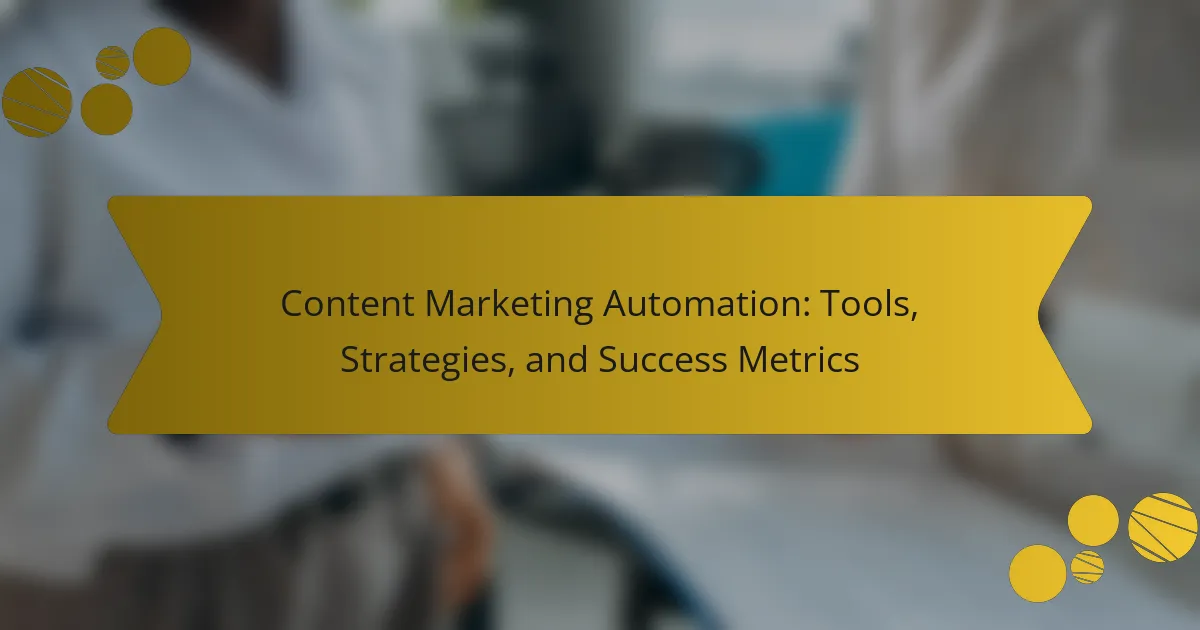Content marketing automation involves the use of software tools to streamline and enhance content marketing tasks, such as scheduling, distribution, and performance analysis. This article explores various automation tools like HubSpot, Marketo, Buffer, CoSchedule, and SEMrush, highlighting their features and benefits in improving marketing efficiency. Additionally, it discusses the role of data analytics and artificial intelligence in personalizing content and optimizing marketing strategies. The article emphasizes the importance of consistent messaging across multiple channels and the necessity of adapting to trends to maintain relevance and effectiveness in content marketing efforts.

What is Content Marketing Automation?
Content marketing automation refers to the use of software to automate content marketing tasks and processes. This includes scheduling posts, distributing content, and analyzing performance metrics. Automation tools streamline workflows, improving efficiency and consistency in content delivery. They enable marketers to reach their audience effectively without manual intervention. According to a study by HubSpot, 63% of companies that exceed their revenue goals have a documented content strategy that often includes automation. This demonstrates the effectiveness of content marketing automation in enhancing overall marketing efforts.
How does Content Marketing Automation function?
Content marketing automation functions by using software to streamline and optimize marketing tasks. This includes scheduling content, managing social media posts, and analyzing performance metrics. Automation tools can segment audiences and personalize content delivery. They enable marketers to create workflows that trigger actions based on user behavior. For instance, if a user downloads a resource, the system can automatically send a follow-up email. According to a study by HubSpot, businesses that use marketing automation see a 451% increase in qualified leads. These tools save time and enhance efficiency in executing marketing strategies.
What are the key components of Content Marketing Automation?
The key components of Content Marketing Automation include content creation, distribution, analytics, and optimization. Content creation involves generating high-quality, relevant material. Distribution refers to the automated sharing of content across various channels. Analytics tracks performance metrics to evaluate effectiveness. Optimization focuses on improving content based on data insights. Together, these components streamline marketing efforts and enhance engagement.
How do these components interact to enhance marketing efforts?
Content marketing automation components interact to streamline processes and improve efficiency. These components include content creation tools, distribution platforms, and analytics software. Content creation tools enable marketers to produce high-quality content quickly. Distribution platforms ensure that content reaches the target audience effectively. Analytics software provides insights into performance and audience engagement.
Together, these tools reduce manual tasks and allow for more strategic planning. For example, automated scheduling of posts can optimize timing for maximum visibility. Additionally, real-time analytics help marketers adjust strategies based on audience behavior. This data-driven approach enhances overall marketing effectiveness and ROI.
According to a report by HubSpot, companies using marketing automation see a 451% increase in qualified leads. This statistic underscores the importance of integrating these components to enhance marketing efforts.
What are the benefits of using Content Marketing Automation?
Content marketing automation streamlines the content creation and distribution process. It saves time by automating repetitive tasks. Automation tools can schedule posts across multiple platforms simultaneously. This increases efficiency and allows marketers to focus on strategy. Consistency in publishing is enhanced through automated scheduling. Data analytics can be integrated to track performance metrics. This leads to better decision-making based on real-time insights. According to a study by HubSpot, companies using automation report a 14.5% increase in sales productivity.
How does Content Marketing Automation improve efficiency?
Content marketing automation improves efficiency by streamlining content creation and distribution processes. It allows marketers to schedule posts in advance, reducing the need for manual intervention. Automation tools can analyze audience behavior, optimizing content for better engagement. This data-driven approach leads to more effective targeting and increased ROI. According to a study by HubSpot, companies using marketing automation see a 14.5% increase in sales productivity. Additionally, automation reduces repetitive tasks, freeing up time for strategic planning and creativity. Overall, content marketing automation enhances productivity and effectiveness in marketing campaigns.
What impact does Content Marketing Automation have on customer engagement?
Content Marketing Automation significantly enhances customer engagement. It allows brands to deliver personalized content at scale. This personalization increases relevance for the audience. Relevant content fosters deeper connections with customers. According to research by HubSpot, automated emails have a 70.5% higher open rate. This statistic illustrates the effectiveness of targeted messaging. Automation also enables timely interactions with customers. Prompt responses can lead to higher satisfaction rates. Overall, content marketing automation drives engagement through tailored experiences.
What challenges might arise with Content Marketing Automation?
Content marketing automation can present several challenges. One challenge is the potential for content quality to decline. Automated tools may produce generic content lacking in creativity. Another challenge is the risk of losing the personal touch in communication. Automated messages can feel impersonal and disengaging to the audience. Additionally, there is the issue of technical difficulties. Software malfunctions can disrupt campaigns and lead to missed opportunities. Data management is also a challenge. Managing large volumes of data can be overwhelming without proper systems in place. Finally, there is the challenge of integration with existing processes. Ensuring that automation tools work seamlessly with current marketing strategies can be complex.
How can organizations overcome common obstacles in implementation?
Organizations can overcome common obstacles in implementation by adopting a structured approach. They should first conduct a thorough needs assessment to identify specific challenges. Effective communication is crucial for aligning team members and stakeholders. Training programs can enhance skills and reduce resistance to change. Utilizing technology tools can streamline processes and improve efficiency. Regular feedback loops help in adjusting strategies as needed. A clear project timeline with milestones ensures accountability. Research indicates that organizations with a defined implementation strategy are 70% more likely to succeed.
What are the potential pitfalls of relying too heavily on automation?
Relying too heavily on automation can lead to several potential pitfalls. One major issue is the loss of human touch in customer interactions. Personalized communication often suffers when automation is prioritized. This can result in decreased customer satisfaction and loyalty. Additionally, over-automation can lead to errors if the system is not properly monitored. Automated processes may also fail to adapt to changing market conditions. This lack of flexibility can hinder a brand’s responsiveness. Furthermore, reliance on automation can create skill gaps among employees. They may become less proficient in essential tasks that automation handles. A study by McKinsey shows that organizations with balanced automation strategies perform better. This highlights the importance of integrating human oversight with automated systems.

What tools are available for Content Marketing Automation?
Content marketing automation tools streamline the process of creating, distributing, and analyzing content. Popular tools include HubSpot, which offers comprehensive marketing automation features. Marketo is another robust solution focused on lead management and analytics. Buffer simplifies social media scheduling and performance tracking. CoSchedule integrates content marketing with social media and email marketing. SEMrush provides content optimization and SEO tools. These tools enhance efficiency and effectiveness in content marketing campaigns.
How do different tools compare in functionality?
Different tools in content marketing automation vary significantly in functionality. Tools like HubSpot offer comprehensive features including email marketing, social media management, and analytics. In contrast, tools such as Buffer focus primarily on social media scheduling and analytics. Additionally, platforms like Mailchimp excel in email marketing but have limited capabilities in social media management. Each tool serves distinct marketing needs. For instance, HubSpot’s all-in-one approach supports integrated campaigns. Mailchimp’s strong email focus is beneficial for businesses prioritizing newsletters. Buffer’s simplicity makes it ideal for small businesses seeking straightforward social media solutions. These differences highlight the importance of selecting a tool that aligns with specific marketing objectives.
What features should be prioritized when selecting a tool?
When selecting a tool for content marketing automation, prioritize user-friendliness, integration capabilities, and analytics features. User-friendliness ensures that team members can easily navigate the tool, leading to higher adoption rates. Integration capabilities allow the tool to connect with existing systems, enhancing workflow efficiency. Analytics features provide insights into campaign performance, enabling data-driven decision-making. According to a survey by HubSpot, 70% of marketers find analytics crucial for measuring success. Prioritizing these features can significantly impact the effectiveness of content marketing strategies.
Which tools are best suited for small businesses versus large enterprises?
Small businesses benefit from user-friendly tools like Mailchimp and Hootsuite. These tools offer affordable pricing and essential features. Mailchimp provides email marketing automation. Hootsuite allows for social media management with ease. Large enterprises require more robust solutions like HubSpot and Marketo. HubSpot offers comprehensive inbound marketing features. Marketo specializes in advanced marketing automation and analytics. These tools support complex campaigns and large data sets. Their scalability and integration capabilities make them suitable for larger organizations.
What are the costs associated with Content Marketing Automation tools?
The costs associated with Content Marketing Automation tools vary widely. Basic tools can range from $10 to $100 per month. Mid-tier solutions typically cost between $100 and $500 monthly. High-end platforms may exceed $500, reaching up to several thousand dollars monthly. Additional costs may arise from setup fees, training, and ongoing support. According to a report by Gartner, companies often allocate 6-10% of their revenue to marketing technology, which includes automation tools. This investment reflects the growing importance of automation in content marketing strategies.
How can businesses budget for Content Marketing Automation?
Businesses can budget for content marketing automation by assessing their current marketing expenses. They should identify areas where automation can reduce costs or improve efficiency. Next, businesses must evaluate different automation tools and their pricing models. This includes subscription fees, implementation costs, and potential training expenses. According to a HubSpot report, companies can save up to 30% on marketing costs by implementing automation. Additionally, businesses should allocate funds for ongoing maintenance and updates of the automation tools. Tracking the return on investment (ROI) from automation efforts is also essential for future budgeting.
What is the return on investment for various tools?
The return on investment (ROI) for various tools in content marketing automation varies widely. ROI is typically calculated as the net profit from the investment divided by the cost of the investment. For example, marketing automation tools can yield an average ROI of 5 to 8 times the initial investment. According to a study by the Content Marketing Institute, businesses that utilize automation tools see a 14.5% increase in sales productivity. Email marketing tools often report an ROI of $42 for every dollar spent, according to the Direct Marketing Association. Social media management tools can also show significant returns, with some users reporting a 300% increase in engagement rates. These figures demonstrate that investing in the right content marketing automation tools can lead to substantial financial benefits.

What strategies can enhance Content Marketing Automation?
Utilizing data analytics can significantly enhance Content Marketing Automation. Data analytics provides insights into audience behavior and preferences. By analyzing engagement metrics, marketers can tailor content to meet audience needs. Personalization increases engagement rates, leading to higher conversion rates. Implementing AI tools can also streamline content creation processes. AI can generate content ideas and optimize distribution channels. Integrating multi-channel marketing ensures broader reach and consistency. Consistent messaging across platforms reinforces brand identity. Regularly testing and refining strategies based on performance metrics is crucial. Adapting to changing trends keeps content relevant and effective.
How can content be optimized for automation?
Content can be optimized for automation by structuring it for easy processing. This involves using clear headings and subheadings to enhance readability. Utilizing templates can streamline content creation and ensure consistency. Metadata should be included to improve searchability and organization. Automated tools can analyze engagement metrics to refine content strategies. Implementing a content calendar aids in scheduling and maintaining a consistent publishing rhythm. Additionally, using SEO best practices increases visibility and effectiveness. Research indicates that structured content increases efficiency in automated systems, leading to better performance outcomes.
What role does audience segmentation play in effective automation?
Audience segmentation is crucial for effective automation. It allows marketers to tailor messages to specific groups. This increases engagement and conversion rates. Segmentation helps identify unique needs and preferences among audiences. According to a study by HubSpot, personalized emails based on segmentation can improve click-through rates by 14%. Effective audience segmentation enhances the relevance of automated campaigns. This relevance leads to higher customer satisfaction and loyalty. By utilizing data analytics, marketers can refine their segmentation strategies over time.
How can businesses personalize content through automation?
Businesses can personalize content through automation by utilizing data-driven insights and segmentation. Automation tools can analyze customer behavior, preferences, and demographics. This data allows businesses to create targeted messages tailored to specific audience segments. For instance, email marketing platforms can automate personalized email campaigns based on user interactions.
According to a study by Epsilon, 80% of consumers are more likely to make a purchase when brands offer personalized experiences. Automation also enables real-time content adjustments based on user engagement. This ensures that the content remains relevant and resonates with the audience. By leveraging these strategies, businesses can enhance customer engagement and drive conversions effectively.
What metrics should be tracked to measure success in Content Marketing Automation?
Key metrics to track for success in Content Marketing Automation include conversion rates, engagement metrics, lead generation, and return on investment (ROI). Conversion rates measure the percentage of users who complete desired actions, indicating effectiveness. Engagement metrics, such as click-through rates and social shares, reflect audience interaction with content. Lead generation tracks the number of new leads acquired through automated campaigns. ROI assesses the financial return relative to the investment in content marketing automation. According to HubSpot, companies that prioritize blogging are 13 times more likely to achieve a positive ROI.
How do engagement metrics differ from conversion metrics?
Engagement metrics measure user interactions with content, while conversion metrics assess completed actions that lead to business goals. Engagement metrics include likes, shares, comments, and time spent on a page. These metrics indicate how well content resonates with an audience. Conversion metrics focus on actions like purchases, sign-ups, or downloads. They reflect the effectiveness of content in driving desired outcomes. For example, a high engagement rate does not guarantee conversions. According to HubSpot, 61% of marketers say generating traffic and leads is their top challenge, highlighting the distinction between engagement and conversion metrics.
What tools can help track these success metrics effectively?
Google Analytics tracks website performance and user engagement metrics effectively. It provides insights into traffic sources, user behavior, and conversion rates. HubSpot offers comprehensive marketing analytics, integrating various metrics from campaigns and social media. SEMrush enables tracking of SEO performance and content effectiveness through keyword rankings and site audits. Hootsuite measures social media engagement metrics, including shares, likes, and comments across platforms. These tools are widely used in the industry for their robust features and data accuracy.
What best practices should be followed in Content Marketing Automation?
Best practices in Content Marketing Automation include defining clear goals, segmenting the audience, and personalizing content. Clear goals guide the automation strategy and measure success. Audience segmentation allows for tailored messaging that resonates with specific groups. Personalization enhances engagement by addressing individual preferences. Utilizing analytics tools enables tracking of performance metrics. Regularly reviewing and optimizing content ensures it remains relevant. Integrating various platforms streamlines the workflow and improves efficiency. Lastly, maintaining a consistent brand voice builds trust and recognition.
How can businesses ensure content quality remains high despite automation?
Businesses can ensure content quality remains high despite automation by implementing strict editorial guidelines. These guidelines should define quality standards for all automated content. Regular audits of automated outputs can help identify areas needing improvement. Training for staff on content creation and curation is essential. Incorporating human oversight in the review process enhances quality control. Utilizing advanced AI tools that prioritize content relevance and engagement is beneficial. Data analytics can track content performance and inform necessary adjustments. Research indicates that companies using a blend of automation and human input achieve higher content effectiveness.
What are the key considerations for maintaining a human touch in automated content?
To maintain a human touch in automated content, personalization is essential. Tailoring content to audience preferences enhances engagement. Understanding user behavior through analytics informs content creation. Incorporating storytelling elements makes content relatable. Utilizing conversational language fosters connection with the audience. Regularly updating content keeps it fresh and relevant. Feedback mechanisms allow for continuous improvement based on audience response. These strategies ensure that automated content resonates on a human level.
Content Marketing Automation refers to the use of software to automate various content marketing tasks, enhancing efficiency and effectiveness in reaching target audiences. The article explores how automation functions, its key components, and the benefits it offers, such as improved customer engagement and increased productivity. It also addresses potential challenges and pitfalls, provides insights into selecting appropriate tools, and outlines strategies for optimizing content through automation. Key metrics for measuring success and best practices for maintaining content quality amidst automation are also discussed, offering a comprehensive overview of the topic.
